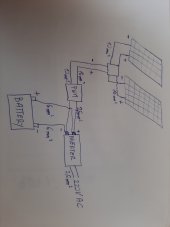CReborn
New Member
- Joined
- Jun 20, 2021
- Messages
- 19
I just realised, that after exchanging my old inverter with a built in circuit breaker (400W with a 40A breaker) with a new 1000W inverter (NV - P1000) which has:
Electronic overload protection with automatic shutdown.
Built-in internal backup DC fuse provides added safety.
Low battery voltage warning followed by automatic shutdown.
High input voltage protection with automatic shutdown.
Over temperature protection with automatic shutdown.
Output short circuit protection.
Do I need another circuit breaker? If so.. where? At the 220V side.. or at the 12V side? How strong? The inverter specs say it gives out 9A at 220V. Should I use a 10A fuse? I believe the electronic protection will kick in much sooner... At 1000W power... that would be 80A on the 12V side. Do I need to put a 80A breaker... or just put a 32A (limiting the output.. which is way below rated 1000W. The biggest surges come from starting the water cooler (60W) and a freezer.. possibly a small 90W water pump. Nothing works constantly.. only for a few minutes on and off...
I realised I haven't given you any specs of my system:
130W panels (2 in parallel, 16A max for both)
10mm2 wire (negative is 10mm2, positive is 16mm2) rated at 60A connecting the panels and the 20A PWM controller. The batteries are connected with a 6mm2 wire (44A rating) to the inverter, and 2,5mm2 (I believe.. or maybe 4mm2) rated at 25A from the PWM to the inverter (only around 50cm long). The battery connection on the inverter, and the PWM connection to the battery is shared on the same inverter terminals. That's how it was connected before.. only with thinner wires, and older components...
Where do I need to put a breaker, if any, and what size..
Thank you
Electronic overload protection with automatic shutdown.
Built-in internal backup DC fuse provides added safety.
Low battery voltage warning followed by automatic shutdown.
High input voltage protection with automatic shutdown.
Over temperature protection with automatic shutdown.
Output short circuit protection.
Do I need another circuit breaker? If so.. where? At the 220V side.. or at the 12V side? How strong? The inverter specs say it gives out 9A at 220V. Should I use a 10A fuse? I believe the electronic protection will kick in much sooner... At 1000W power... that would be 80A on the 12V side. Do I need to put a 80A breaker... or just put a 32A (limiting the output.. which is way below rated 1000W. The biggest surges come from starting the water cooler (60W) and a freezer.. possibly a small 90W water pump. Nothing works constantly.. only for a few minutes on and off...
I realised I haven't given you any specs of my system:
130W panels (2 in parallel, 16A max for both)
10mm2 wire (negative is 10mm2, positive is 16mm2) rated at 60A connecting the panels and the 20A PWM controller. The batteries are connected with a 6mm2 wire (44A rating) to the inverter, and 2,5mm2 (I believe.. or maybe 4mm2) rated at 25A from the PWM to the inverter (only around 50cm long). The battery connection on the inverter, and the PWM connection to the battery is shared on the same inverter terminals. That's how it was connected before.. only with thinner wires, and older components...
Where do I need to put a breaker, if any, and what size..
Thank you
Last edited:



